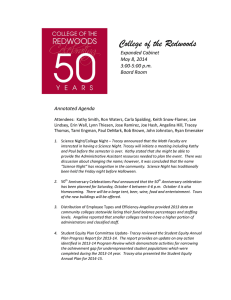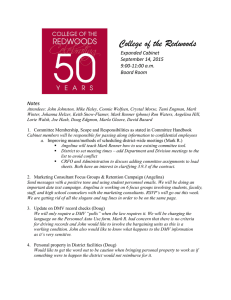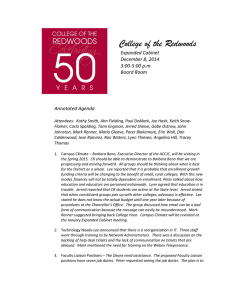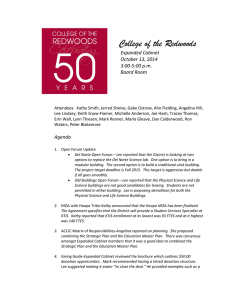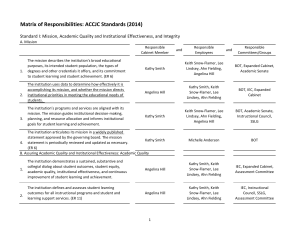Matrix of Responsibilities: ACCJC Standards (2014) Standard I: Mission, Academic Quality and Institutional Effectiveness, and Integrity
advertisement
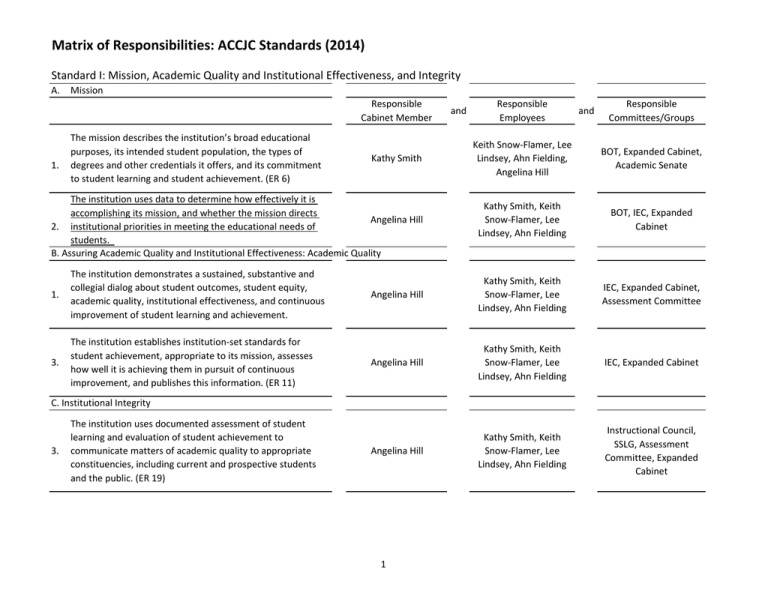
Matrix of Responsibilities: ACCJC Standards (2014) Standard I: Mission, Academic Quality and Institutional Effectiveness, and Integrity A. Mission Responsible Cabinet Member 1. The mission describes the institution’s broad educational purposes, its intended student population, the types of degrees and other credentials it offers, and its commitment to student learning and student achievement. (ER 6) 1. 3. The institution establishes institution‐set standards for student achievement, appropriate to its mission, assesses how well it is achieving them in pursuit of continuous improvement, and publishes this information. (ER 11) Responsible Employees and Responsible Committees/Groups Keith Snow‐Flamer, Lee Lindsey, Ahn Fielding, Angelina Hill BOT, Expanded Cabinet, Academic Senate Kathy Smith, Keith Snow‐Flamer, Lee Lindsey, Ahn Fielding BOT, IEC, Expanded Cabinet Angelina Hill Kathy Smith, Keith Snow‐Flamer, Lee Lindsey, Ahn Fielding IEC, Expanded Cabinet, Assessment Committee Angelina Hill Kathy Smith, Keith Snow‐Flamer, Lee Lindsey, Ahn Fielding IEC, Expanded Cabinet Angelina Hill Kathy Smith, Keith Snow‐Flamer, Lee Lindsey, Ahn Fielding Instructional Council, SSLG, Assessment Committee, Expanded Cabinet Kathy Smith The institution uses data to determine how effectively it is accomplishing its mission, and whether the mission directs Angelina Hill 2. institutional priorities in meeting the educational needs of students. B. Assuring Academic Quality and Institutional Effectiveness: Academic Quality The institution demonstrates a sustained, substantive and collegial dialog about student outcomes, student equity, academic quality, institutional effectiveness, and continuous improvement of student learning and achievement. and C. Institutional Integrity 3. The institution uses documented assessment of student learning and evaluation of student achievement to communicate matters of academic quality to appropriate constituencies, including current and prospective students and the public. (ER 19) 1 Responsible Cabinet Member and Responsible Employees and Responsible Committees/Groups The institution agrees to comply with Eligibility Requirements, Accreditation Standards, Commission policies, guidelines, and requirements for public disclosure, institutional reporting, team visits, and prior approval of 12. substantive changes. When directed to act by the Commission, the institution responds to meet requirements within a time period set by the Commission. It discloses information required by the Commission to carry out its accrediting responsibilities. (ER 21) Kathy Smith Angelina Hill Expanded Cabinet The institution advocates and demonstrates honesty and integrity in its relationships with external agencies, including compliance with regulations and statutes. It describes itself 13. in consistent terms to all of its accrediting agencies and communicates any changes in its accredited status to the Commission, students, and the public. (ER 21) Kathy Smith Angelina Hill Expanded Cabinet Kathy Smith Ahn Fielding, Lee Lindsey, Keith Snow‐ Flamer, Angelina Hill Expanded Cabinet Kathy Smith Michelle Anderson Expanded Cabinet The institution ensures that its commitments to high quality education, student achievement and student learning are 14. paramount to other objectives such as generating financial returns for investors, contributing to a related or parent organization, or supporting external interests. Standard IV: Leadership and Governance A. Decision‐Making Roles and Processes 1. Institutional leaders create an environment for empowerment, innovation, and institutional excellence. They encourage staff, faculty, administrators, and students, no matter what their official titles, to take initiative in improving the practices, programs, and services in which they are involved. When ideas for improvement have policy or significant institution‐wide implications, systematic participative processes are used to assure effective discussion, planning, and implementation. 2 Responsible Cabinet Member and Responsible Employees and Responsible Committees/Groups 3. Administrators and faculty, through policy and procedures, have a substantive and clearly defined role in institutional governance and exercise a substantial voice in institutional policies, planning, and budget that relate to their areas of responsibility and expertise. Kathy Smith Michelle Anderson Expanded Cabinet 5. Through its system of board and institutional governance, the institution ensures the appropriate consideration of relevant perspectives; decision‐making aligned with expertise and responsibility; and timely action on institutional plans, policies, curricular change, and other key considerations. Kathy Smith Keith Snow‐Flamer, Lee Lindsey, Ahn Fielding, Angelina Hill Expanded Cabinet 6. The processes for decision‐making and the resulting decisions are documented and widely communicated across the institution. Kathy Smith Ahn Fielding, Lee Lindsey, Keith Snow‐ Flamer, Angelina Hill Expanded Cabinet 7. Leadership roles and the institution’s governance and decision‐making policies, procedures, and processes are regularly evaluated to assure their integrity and effectiveness. The institution widely communicates the results of these evaluations and uses them as the basis for improvement. Kathy Smith Ahn Fielding, Lee Lindsey, Keith Snow‐ Flamer, Angelina Hill Expanded Cabinet Kathy Smith Ahn Fielding, Lee Lindsey, Keith Snow‐ Flamer, Angelina Hill IEC, Expanded Cabinet B. Chief Executive Officer 1. The institutional chief executive officer (CEO) has primary responsibility for the quality of the institution. The CEO provides effective leadership in planning, organizing, budgeting, selecting and developing personnel, and assessing institutional effectiveness. 3 Responsible Cabinet Member 3. 4. 5. 6. Through established policies and procedures, the CEO guides institutional improvement of the teaching and learning environment by: • establishing a collegial process that sets values, goals, and priorities; • ensuring the college sets institutional performance standards for student achievement; • ensuring that evaluation and planning rely on high quality research and analysis of external and internal conditions; • ensuring that educational planning is integrated with resource planning and allocation to support student achievement and learning; • ensuring that the allocation of resources supports and improves learning and achievement; and • establishing procedures to evaluate overall institutional planning and implementation efforts to achieve the mission of the institution. The CEO has the primary leadership role for accreditation, ensuring that the institution meets or exceeds Eligibility Requirements, Accreditation Standards, and Commission policies at all times. Faculty, staff, and administrative leaders of the institution also have responsibility for assuring compliance with accreditation requirements. The CEO assures the implementation of statutes, regulations, and governing board policies and assures that institutional practices are consistent with institutional mission and policies, including effective control of budget and expenditures. The CEO works and communicates effectively with the communities served by the institution and Responsible Employees and Responsible Committees/Groups Kathy Smith Ahn Fielding, Lee Lindsey, Keith Snow‐ Flamer, Angelina Hill IEC, Expanded Cabinet Kathy Smith Ahn Fielding, Lee Lindsey, Keith Snow‐ Flamer, Angelina Hill IEC, Expanded Cabinet Kathy Smith Ahn Fielding, Lee Lindsey, Keith Snow‐ Flamer, Angelina Hill Expanded Cabinet Kathy Smith Ahn Fielding, Lee Lindsey, Keith Snow‐ Flamer, Angelina Hill Expanded Cabinet 4
